Solar eclipse of July 23, 2093
An annular solar eclipse will occur on July 23, 2093. A solar eclipse occurs when the Moon passes between Earth and the Sun, thereby totally or partly obscuring the image of the Sun for a viewer on Earth. An annular solar eclipse occurs when the Moon's apparent diameter is smaller than the Sun's, blocking most of the Sun's light and causing the Sun to look like an annulus (ring). An annular eclipse appears as a partial eclipse over a region of the Earth thousands of kilometres wide.
| Solar eclipse of July 23, 2093 | |
|---|---|
 Map | |
| Type of eclipse | |
| Nature | Annular |
| Gamma | 0.5717 |
| Magnitude | 0.9463 |
| Maximum eclipse | |
| Duration | 311 sec (5 m 11 s) |
| Coordinates | 54.6°N 1.3°E |
| Max. width of band | 241 km (150 mi) |
| Times (UTC) | |
| Greatest eclipse | 12:32:04 |
| References | |
| Saros | 147 (27 of 80) |
| Catalog # (SE5000) | 9717 |
Related eclipses
Solar eclipses 2091–2094
This eclipse is a member of a semester series. An eclipse in a semester series of solar eclipses repeats approximately every 177 days and 4 hours (a semester) at alternating nodes of the Moon's orbit.[1]
| Solar eclipses 2091–2094 | |||||
|---|---|---|---|---|---|
| 122 | February 18, 2091 Partial |
127 | August 15, 2091 Total | ||
| 132 | February 7, 2092 Annular |
137 | August 3, 2092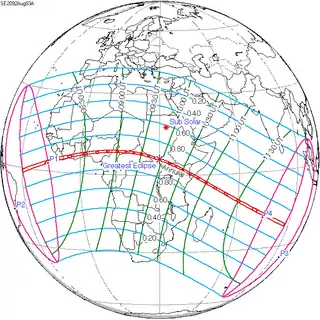 Annular | ||
| 142 | January 27, 2093 Total |
147 | July 23, 2093 Annular | ||
| 152 | January 16, 2094 Total |
157 | July 12, 2094 Partial | ||
Saros 147
Solar saros 147, repeating every about 18 years and 11 days, contains 80 events. The series started with a partial solar eclipse on October 12, 1624. It has annular eclipses from May 31, 2003, to July 31, 2706. There are no total eclipses in this series. The series ends at member 80 as a partial eclipse on February 24, 3049. The longest annular eclipse will be on November 21, 2291, at 9 minutes and 41 seconds.[2]
| Series members 17–27 occur between 1901 and 2100: | ||
|---|---|---|
| 17 | 18 | 19 |
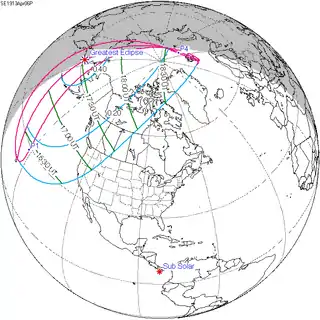 April 6, 1913 |
 April 18, 1931 |
 April 28, 1949 |
| 20 | 21 | 22 |
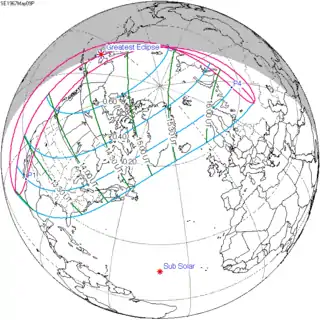 May 9, 1967 |
 May 19, 1985 |
 May 31, 2003 |
| 23 | 24 | 25 |
 June 10, 2021 |
 June 21, 2039 |
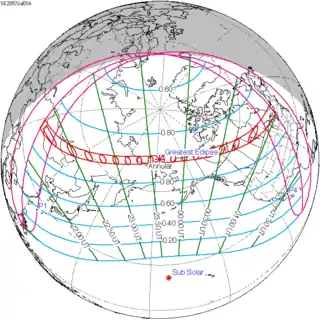 July 1, 2057 |
| 26 | 27 | |
 July 13, 2075 |
 July 23, 2093 | |
Inex series
This eclipse is a part of the long period inex cycle, repeating at alternating nodes, every 358 synodic months (≈ 10,571.95 days, or 29 years minus 20 days). Their appearance and longitude are irregular due to a lack of synchronization with the anomalistic month (period of perigee). However, groupings of 3 inex cycles (≈ 87 years minus 2 months) comes close (≈ 1,151.02 anomalistic months), so eclipses are similar in these groupings.
| Inex series members between 1901 and 2100: | ||
|---|---|---|
 November 22, 1919 (Saros 141) |
 November 1, 1948 (Saros 142) |
 October 12, 1977 (Saros 143) |
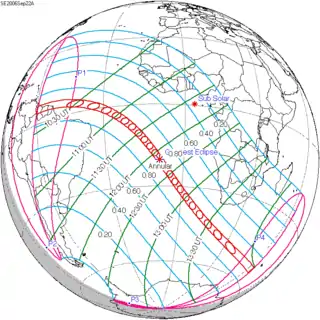 September 22, 2006 (Saros 144) |
 September 2, 2035 (Saros 145) |
 August 12, 2064 (Saros 146) |
 July 23, 2093 (Saros 147) |
||
Notes
- van Gent, R.H. "Solar- and Lunar-Eclipse Predictions from Antiquity to the Present". A Catalogue of Eclipse Cycles. Utrecht University. Retrieved 6 October 2018.
- Saros Series Catalog of Solar Eclipses NASA Eclipse Web Site.
References
- Earth visibility chart and eclipse statistics Eclipse Predictions by Fred Espenak, NASA/GSFC
.jpg.webp)

